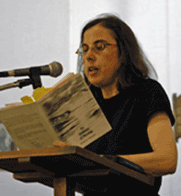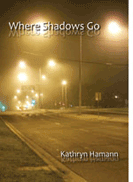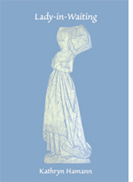Kathryn Hamann – September 10 2017
Dementia Awareness Month (Alzheimer’s Australia) – September 2017
 Christine Kathryn Hamann, known as Kathryn Hamann, lives and writes in Melbourne with her family and two cats (Audrey Bee and Charlemagne of Celestial Length). She is a wife, mother, sister, aunt, great-aunt, friend, lover of the Feline, and award-winning poet. Her work has appeared Australia-wide as well as overseas. Kathryn worked as a teacher and research assistant before becoming a poet. Her other poetry collections include Arc of Promise; Pelargoniums, a verse narrative about autism; An Embrace of Morning; Saint Moon; The Threshold of Silence; A Poor Canticle; and A Slight Fuzzing of Perspective, joint winner of the 2011 Caleb Award poetry section. Kathryn wrote the poetic accompaniment to her husband Conrad’s book of sketches, Cat – At Work, some poems from which appear in Best Australian Poems: 2011. She has also worked with cartoonist, Penne Gillies, to create Sentenced to Transportation. How to Get Around Melbourne. Or Not. With Coffee. A Tour de Farce.
Christine Kathryn Hamann, known as Kathryn Hamann, lives and writes in Melbourne with her family and two cats (Audrey Bee and Charlemagne of Celestial Length). She is a wife, mother, sister, aunt, great-aunt, friend, lover of the Feline, and award-winning poet. Her work has appeared Australia-wide as well as overseas. Kathryn worked as a teacher and research assistant before becoming a poet. Her other poetry collections include Arc of Promise; Pelargoniums, a verse narrative about autism; An Embrace of Morning; Saint Moon; The Threshold of Silence; A Poor Canticle; and A Slight Fuzzing of Perspective, joint winner of the 2011 Caleb Award poetry section. Kathryn wrote the poetic accompaniment to her husband Conrad’s book of sketches, Cat – At Work, some poems from which appear in Best Australian Poems: 2011. She has also worked with cartoonist, Penne Gillies, to create Sentenced to Transportation. How to Get Around Melbourne. Or Not. With Coffee. A Tour de Farce.
 Where Shadows Go
Where Shadows Go
Mono Unlimited, 2013; ISBN 9780980868593
This book is one of lamentation. It is a search for some foothold on the slippery slope of chronic and terminal illness. It includes photography and artwork, and comes with a CD by William Hamann of instrumental music to accompany the poems. “Through the window of her own pain and suffering, the poet examines the question of ‘Why?’ …. This does not always make for comfortable reading, as the poet rails against the church, the medical profession, fair weather friends and an apparently absent God. Although Hamann warns the reader that this book ‘is the grumpy poet’s guide to illness’ (p. v), it is not all doom and gloom. There is beauty, humour, and a determination to cling to God even when it doesn’t feel as if He’s there.” – Nola, Goodreads
 Lady-in-Waiting
Lady-in-Waiting
Mono Unlimited, 2014; ISBN 9780987566362
On Where Shadows Go and Lady-in-Waiting: “In each of these volumes Hamann has focused on the journey of the aged, and especially on the trials and suffering associated with dementia. The physical and mental seesawing of both victim and carer are presented in a variety of forms, from simple couplets to three-page narratives. Appropriate photographs and drawings add visual interest …. Faith is challenged and so is God; the inadequacies of humanity are made clear, and also the plethora of emotions attached to the ending of a life. Despite the personal and intimate nature of the material, these books might be helpful to others experiencing similar circumstances.” LH – Goodreads
